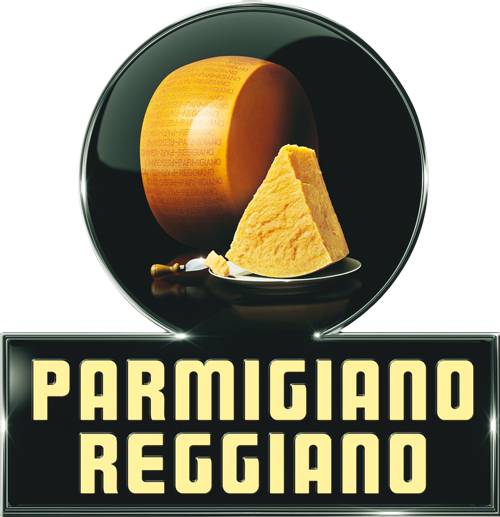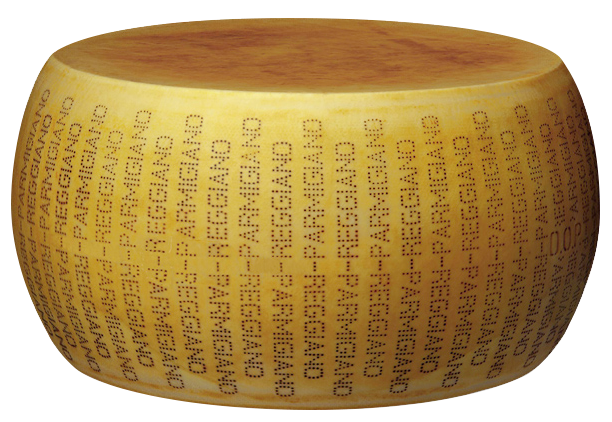
Parmigiano Reggiano wheels
Parmigiano Reggiano PDO with an average aging of 16 months in whole wheels. Ideal for Horeca.
Average weight: approx. 37 kg
Dimensions: diameter 35/45 cm and height 18/25 cm
Average weight: approx. 37 kg
Dimensions: diameter 35/45 cm and height 18/25 cm
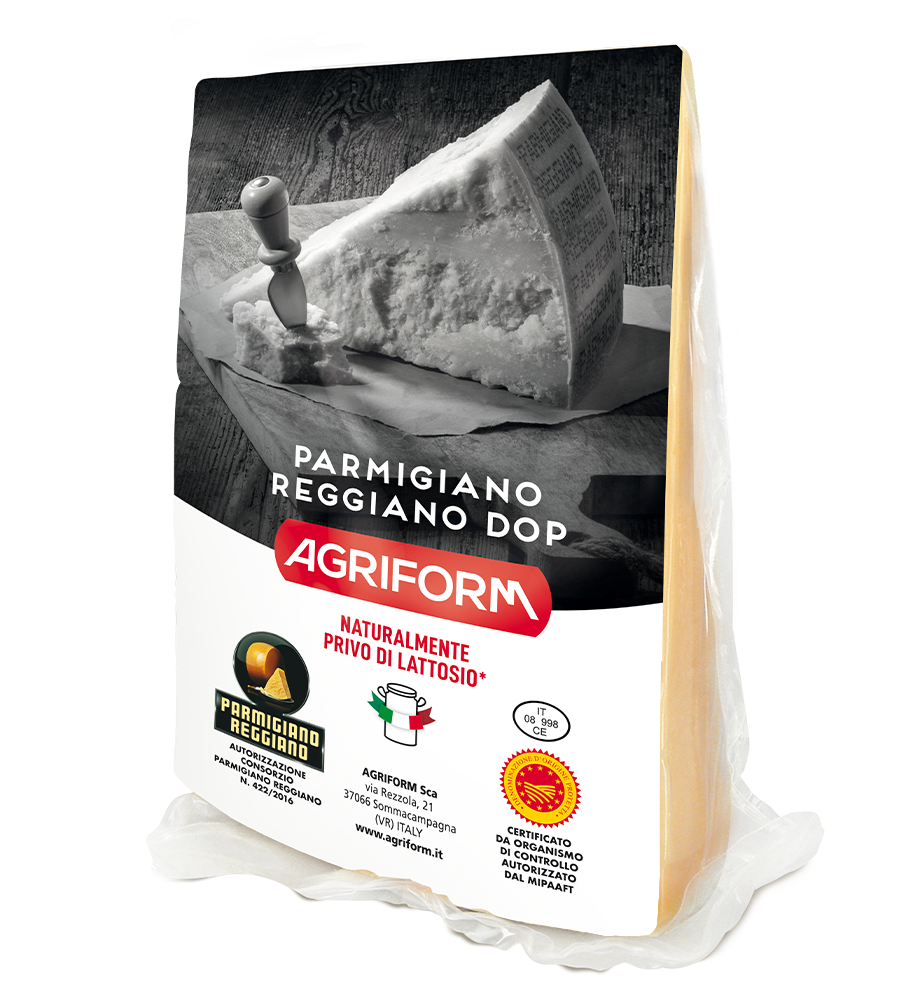
Vacuum packed Parmigiano Reggiano
Vacuum packing is the classic packaging for Parmigiano Reggiano cheese. The total absence of oxygen allows the product to be stored up to 12 months from the packaging date.
Vacuum packed Grana Padano is available in the "catering" formats of 1/4, 1/8 and 1/16 wheel portions and in “retail” formats from 200g to 1kg.
Vacuum packed Grana Padano is available in the "catering" formats of 1/4, 1/8 and 1/16 wheel portions and in “retail” formats from 200g to 1kg.
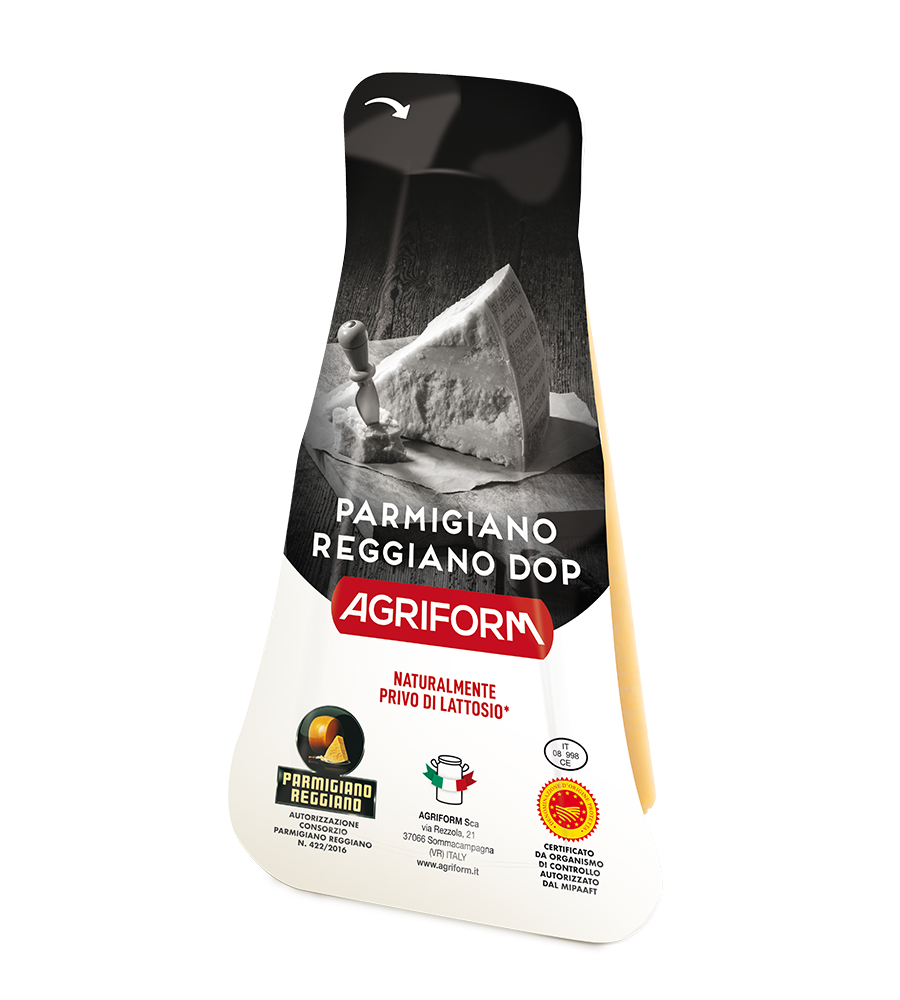
Parmigiano Reggiano with thermoformed package
The thermoformed package can be gas-flushed (hard tray with open & close film and shelf life up to 4 months) or vacuum packed (flexible easy-open package and shelf life up to 6 months). It is available in 200g and 250g fix weight wedges.
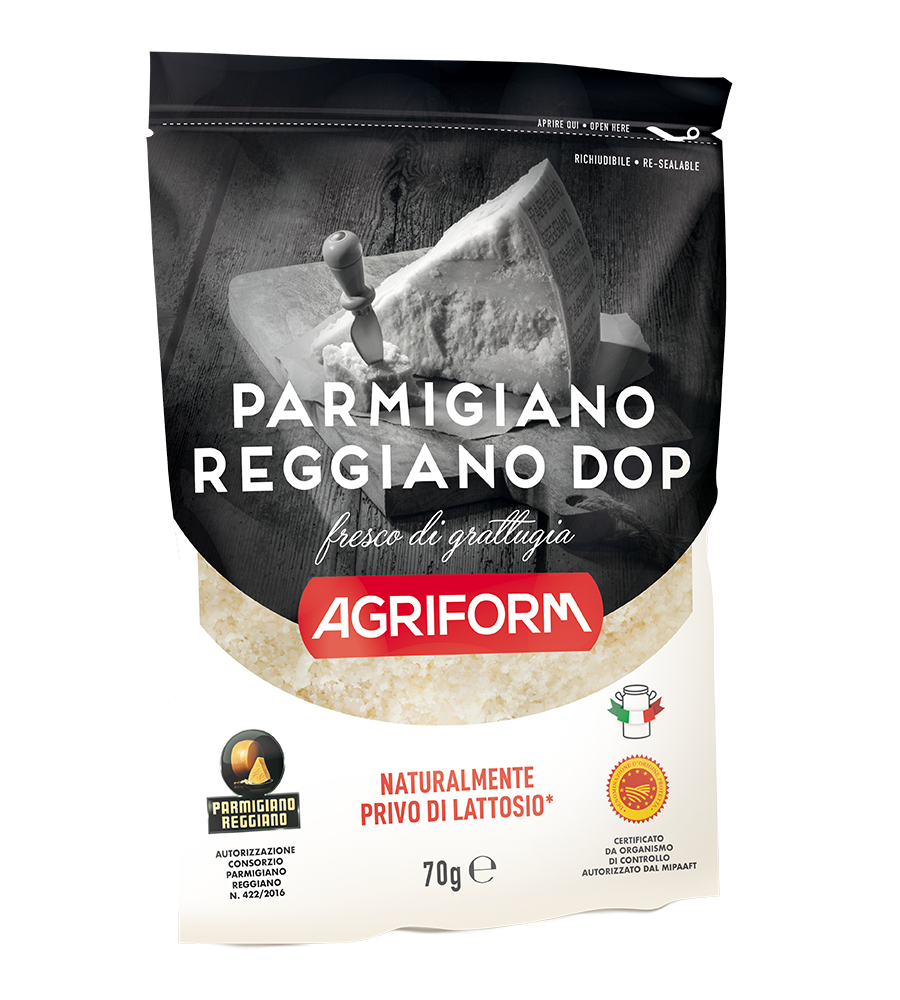
Grated Parmigiano Reggiano
This product is entirely obtained from freshly grated wheels of Grana Padano PDO cheese.
It is available in 70g, 500g bags for retail, and 1kg and 2,5 kg bags for Horeca. All retail packages have a resalable zip lock.
It is available in 70g, 500g bags for retail, and 1kg and 2,5 kg bags for Horeca. All retail packages have a resalable zip lock.
Parmigiano Reggiano PDO
A cheese of the greatest quality, famous throughout the world, produced in the provinces of Parma, Reggio Emilia, Modena, and part of Mantua and Bologna.
Made from low-fat cow's milk, it is a hard, granular and semi-fat cheese that is white or straw yellow in colour with a natural straw yellow rind. It is characterized by a rich, delicate and full flavour that is never sharp.
Made from low-fat cow's milk, it is a hard, granular and semi-fat cheese that is white or straw yellow in colour with a natural straw yellow rind. It is characterized by a rich, delicate and full flavour that is never sharp.

Parmigiano Reggiano wheels
Parmigiano Reggiano PDO with an average aging of 16 months in whole wheels. Ideal for Horeca.
Average weight: approx. 37 kg
Dimensions: diameter 35/45 cm and height 18/25 cm
Average weight: approx. 37 kg
Dimensions: diameter 35/45 cm and height 18/25 cm

Vacuum packed Parmigiano Reggiano
Vacuum packing is the classic packaging for Parmigiano Reggiano cheese. The total absence of oxygen allows the product to be stored up to 12 months from the packaging date.
Vacuum packed Grana Padano is available in the "catering" formats of 1/4, 1/8 and 1/16 wheel portions and in “retail” formats from 200g to 1kg.
Vacuum packed Grana Padano is available in the "catering" formats of 1/4, 1/8 and 1/16 wheel portions and in “retail” formats from 200g to 1kg.

Parmigiano Reggiano with thermoformed package
The thermoformed package can be gas-flushed (hard tray with open & close film and shelf life up to 4 months) or vacuum packed (flexible easy-open package and shelf life up to 6 months). It is available in 200g and 250g fix weight wedges.

Grated Parmigiano Reggiano
This product is entirely obtained from freshly grated wheels of Grana Padano PDO cheese.
It is available in 70g, 500g bags for retail, and 1kg and 2,5 kg bags for Horeca. All retail packages have a resalable zip lock.
It is available in 70g, 500g bags for retail, and 1kg and 2,5 kg bags for Horeca. All retail packages have a resalable zip lock.
PDO
Protected Denomination of Origin
DETAILS:
• Average weight of the wheel: 37 Kg
• Diameter: 35-45 cm
• Height: 18-24 cm
• Ingredients: milk, salt, rennet
AGEING:
• form 12 to over 30 months
NUTRITION FACTS (FOR 100 G):
• Energy: 1671 kJ/402 kcal
• Fat: 30g
of which satures: 20g
• Carbohydrates: 0g
of which sugars: 0g
• Protein: 32g
• Salt: 1,6g
Protected Denomination of Origin
DETAILS:
• Average weight of the wheel: 37 Kg
• Diameter: 35-45 cm
• Height: 18-24 cm
• Ingredients: milk, salt, rennet
AGEING:
• form 12 to over 30 months
NUTRITION FACTS (FOR 100 G):
• Energy: 1671 kJ/402 kcal
• Fat: 30g
of which satures: 20g
• Carbohydrates: 0g
of which sugars: 0g
• Protein: 32g
• Salt: 1,6g
Obtained by combining raw cow’s milk from the evening milking, left to rest and partially skimmed, with the whole milk from the morning milking. The use of fermentation inhibitors is not allowed. The minimum maturation time is 12 months and can be extended up to 2 years and more.
Parmigiano-Reggiano is a cheese of ancient origin and its characteristics and processing methods have remained unchanged over time. Still today, cheese masters continue the tradition of making their cheese with only milk and rennet, with strict respect to the centuries-old methods.
The birth of this fine cheese, a symbol of Italian cheese making excellence, dates back to about the 12th century, even though the Romans and Etruscans were already familiar with this cheese produced in the Reggio Emilia area.
The first evidence comes from Cistercian monasteries in Parma and Benedictine monasteries in Reggio-Emilia: thanks to the abundant streams of water and broad pastures, this hard cheese, obtained by processing the milk in large boilers, quickly spread throughout the area around Emilia. A milk with a particular and distinctive aroma that still today characterises the cheese, coming from typical forage from the pastures, composed of clover and lucerne. Already back then, Parmigiano-Reggiano cheese had reached its perfect typicality, which has remained unchanged for nine centuries up to the present day, thoroughly expressing the tradition and precision of the monks.
“And there was a mountain of grated Parmigiano cheese, on which people were making nothing but maccheroni and raviolis, and cooking them in chicken broth...”
This dates back to 1351, when Giovanni Boccaccio wrote in Decamerone, a writing in which Parmigiano Reggiano was mentioned as a product of excellence, of universally renowned fame.
In the 16th century it was the subject of Italian pride and undisputed star of noble lunches, where it was especially enjoyed when combined with fresh fruit. It is said that, before dying, Molière (1600) had asked for one last chunk of this white gold.
Evidence of a success story also comes from the 1800’s, a prodigal century for quotes and honours for Parmigiano Reggiano. It seems that the French emperor Napoleon Bonaparte loved to eat a dish of green beans and Parmigiano Reggiano, prepared by his personal chef which was discovered thanks to this second wife, the Duchess of Parma Maria Luigia.
The success of this divine product is endless, and today it is one of the most highly representative products of Italian gastronomy in the entire world.
Parmigiano Reggiano was awarded the Protected Designation of Origin status in 1955.
The birth of this fine cheese, a symbol of Italian cheese making excellence, dates back to about the 12th century, even though the Romans and Etruscans were already familiar with this cheese produced in the Reggio Emilia area.
The first evidence comes from Cistercian monasteries in Parma and Benedictine monasteries in Reggio-Emilia: thanks to the abundant streams of water and broad pastures, this hard cheese, obtained by processing the milk in large boilers, quickly spread throughout the area around Emilia. A milk with a particular and distinctive aroma that still today characterises the cheese, coming from typical forage from the pastures, composed of clover and lucerne. Already back then, Parmigiano-Reggiano cheese had reached its perfect typicality, which has remained unchanged for nine centuries up to the present day, thoroughly expressing the tradition and precision of the monks.
“And there was a mountain of grated Parmigiano cheese, on which people were making nothing but maccheroni and raviolis, and cooking them in chicken broth...”
This dates back to 1351, when Giovanni Boccaccio wrote in Decamerone, a writing in which Parmigiano Reggiano was mentioned as a product of excellence, of universally renowned fame.
In the 16th century it was the subject of Italian pride and undisputed star of noble lunches, where it was especially enjoyed when combined with fresh fruit. It is said that, before dying, Molière (1600) had asked for one last chunk of this white gold.
Evidence of a success story also comes from the 1800’s, a prodigal century for quotes and honours for Parmigiano Reggiano. It seems that the French emperor Napoleon Bonaparte loved to eat a dish of green beans and Parmigiano Reggiano, prepared by his personal chef which was discovered thanks to this second wife, the Duchess of Parma Maria Luigia.
The success of this divine product is endless, and today it is one of the most highly representative products of Italian gastronomy in the entire world.
Parmigiano Reggiano was awarded the Protected Designation of Origin status in 1955.
The production area for Parmigiano-Reggiano is fairly restricted: it includes the provinces of Parma, Reggio Emilia, Modena and parts of the provinces of Mantua and Bologna between the Po and Reno rivers. Both the production of milk and the transformation into cheese and its portioning are done in this area. Only raw milk produced in this territory is used for the production of Parmigiano-Reggiano. It’s a special milk, characterized by a singular and intense bacterial activity from a native microbial flora that is influenced by environmental factors, especially by local hay which is the main feed for the cows dedicated to this production: this firmly links Parmigiano-Reggiano to its territory, which makes it impossible to be reproduced in any other part of the world, even if the same production techniques are used.
Excellent alone as an appetizer or snack, Parmigiano is used in many typical recipes from the production area as well as throughout Italy.
Unbeatable when grated to enhance first courses, from pasta (with tomato sauce, butter, vegetables, meat sauce, pesto) to vegetable soups, rice and other grains.
Ideal as an ingredient in au gratin recipes, it enhances the flavour of filled pastas, potato torts, lasagnas, gnocchi alla romana, stuffed vegetables; when combined with eggs, delicious frittatas can be made; mixed with meat it enriches meatballs and meatloafs.
In slivers, it is excellent in salads, on bresaola and thinly sliced raw meats. It is particularly indicated when served with Balsamic Vinegar or fruit (especially pears and grapes, but also walnuts and figs) to create a very sophisticated dessert.
Parmigiano Reggiano pairs very nicely with Lambrusco, full-bodied red wines, semi-dry fortified wines like Marsala or Malvasia, dessert wines and top quality brut sparkling wines such as Franciacorta, Cava or Champagne.
Unbeatable when grated to enhance first courses, from pasta (with tomato sauce, butter, vegetables, meat sauce, pesto) to vegetable soups, rice and other grains.
Ideal as an ingredient in au gratin recipes, it enhances the flavour of filled pastas, potato torts, lasagnas, gnocchi alla romana, stuffed vegetables; when combined with eggs, delicious frittatas can be made; mixed with meat it enriches meatballs and meatloafs.
In slivers, it is excellent in salads, on bresaola and thinly sliced raw meats. It is particularly indicated when served with Balsamic Vinegar or fruit (especially pears and grapes, but also walnuts and figs) to create a very sophisticated dessert.
Parmigiano Reggiano pairs very nicely with Lambrusco, full-bodied red wines, semi-dry fortified wines like Marsala or Malvasia, dessert wines and top quality brut sparkling wines such as Franciacorta, Cava or Champagne.

